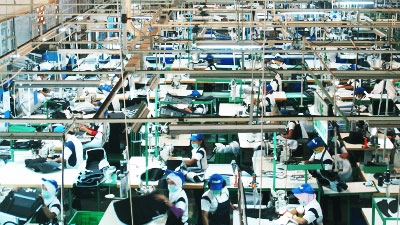Challenges
Since the Asian financial crisis, a number of macroeconomic challenges have led to a decline in the rate of growth in Indonesia’s manufacturing sector. The real appreciation of the rupiah, rising unit labor costs, a shift to commodities and resource-intensive sectors, strong international competition (especially from China) and a tightening of profit margins have all made Indonesia’s manufacturing sector less competitive than its regional neighbors. Productivity growth in Indonesia is also lagging relative to its competitors.
Major micro level challenges for Indonesian firms are high transportation and logistics costs, difficulties in getting credit, and a lack of transparency and certainty in regulations. These discourage new entrants from setting up shop and prevent existing manufacturers from expanding and enjoying economies of scale.
The “Missing Middle”
The myriad challenges have led to a “missing middle” – a large proportion of small and unproductive manufacturing firms – preventing the manufacturing sector from making a greater contribution to Indonesian economic growth and job creation.
Picking up the Pace
Despite these challenges, Indonesia’s manufacturing sector may be picking up pace. Demand has grown strongly in recent years and recent investment data suggest that growth is quickening. At the same time, Indonesia’s rapidly growing middle-class and competitive workforce are luring more foreign investors into the sector. Growing opportunities in the region are also making Indonesia look even more attractive.
Future Potential
Indonesia could potentially boost its global market share in manufacturing, create millions of new jobs and facilitate structural transformation. But riding on the back of domestic and international demand is not enough. To improve overall competitiveness and sustain growth, the government and private sector need to overcome the main challenges facing the manufacturing sector.
Policy Strategies
To address the macro and microeconomic challenges, policies are needed to improve cost competitiveness and reduce opportunity costs for investment. Policies to improve value-based competitiveness in manufacturing are also needed to advance and sustain growth. Specific policy recommendations include:
- Making it easier for smaller firms to grow and fill in the “missing middle”, and for inefficient firms to exit, especially by opening up access to resources and finance and simplifying labor market conditions;
- Making it easier for non-exporting firms to become exporters and for exporters to expand their market shares abroad, especially by resolving transportation and logistics issues and reducing non-tariff barriers to market access abroad (e.g., by promoting international standards and improving the standards regime);
- Helping firms move up the value chain, for example, through greater investment in education, worker skills and technology and greater cooperation between firms and educational institutions; and
- Increasing overall market efficiency by encouraging competition and maintaining economic openness.
Coordination and Consultation
Reviving the manufacturing sector also requires greater coordination across government agencies and local governments. The private sector also needs to be brought into policy discussions and its feedback needs to be recorded through a credible dialogue mechanism.

